The Intel Skylake i7-6700K Overclocking Performance Mini-Test to 4.8 GHz
by Ian Cutress on August 28, 2015 2:30 PM ESTGaming Benchmarks: Integrated Graphics
Our regular benchmarks for processor reviews consist of Alien Isolation, Total War: Attila, Grand Theft Auto V, GRID: Autosport and Middle Earth: Shadow of Mordor. Rather than the full run of graphics cards from $70 and up, we are limiting here to just the low-end testing on integrated graphics and a full on ASUS GTX 980 Strix assault.
Integrated Graphics
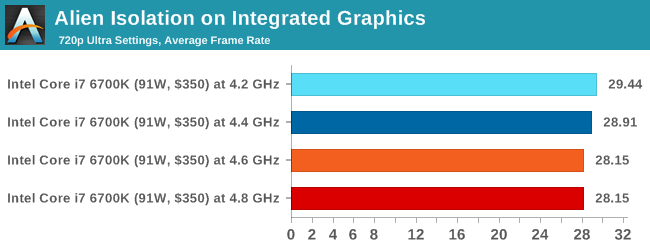
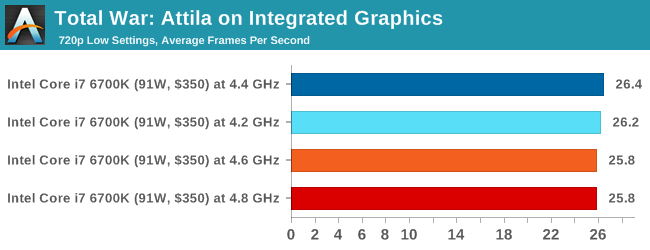
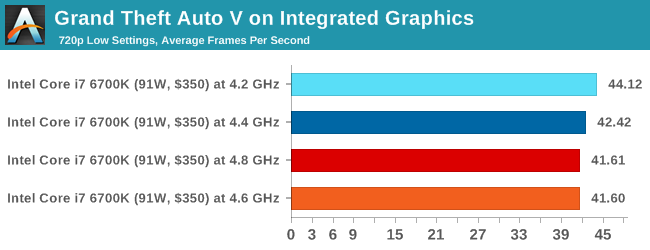
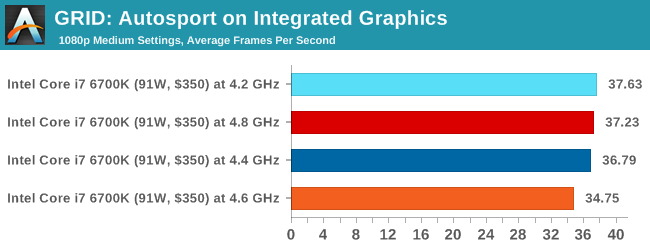
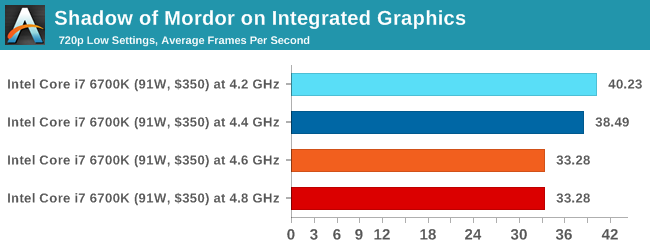
Conclusions on Integrated Graphics
It is clear that an overclocked processor gives worse integrated graphics performance when the graphics setting is left on Auto. In some titles, the more overclock gives more of an effect, although 4.6 GHz and 4.8 GHz seems to get similar numbers. The key here is power budget, and by forcing the CPU to work harder, in order to balance the total power the IGP has to decrease in performance - and requires being forced at a certain frequency as a result. These CPUs are not necessarily purchased for their integrated graphics performance, however. Although if DirectX 12 titles are capable of multi-adapter modes where the Intel IGP can be used, it could result in tests for an interesting balance in order to get the best performance.











103 Comments
View All Comments
Oxford Guy - Sunday, August 30, 2015 - link
Who is the one trolling?SanX - Saturday, August 29, 2015 - link
If Intel by moving to 14nm (with its potentially twice smaller surface area versus 22nm) made mainstream octacores overclockable like 4770k/4790k i'd be interested. Otherwise it is hard to see any progress at all. Shame, even cellphones are octacores.Oxford Guy - Sunday, August 30, 2015 - link
You can get AMD FX to run at over 4.5 GHz with generally only decent cooling. As for seeing progress, overclocking may be less and less viable as process nodes shrink.Oxford Guy - Sunday, August 30, 2015 - link
We seem to be seeing this borne out in the review, too. Voltages remain too high. Then, when that fails to do the trick, reviewers try to claim that unstable settings are good enough.stephenbrooks - Sunday, August 30, 2015 - link
I wonder how much of this is choice of the "optimum" frequency for the process? I think Intel only has two processes per node, a standard and a low-voltage/low-power one. If the standard one has been stretched to pretty low powers (10W?), the top end suffers from high voltages because it's not optimal there. They'd end up having to commission a 3rd "high frequency" process to get these top end chips right. There's no incentive until they have a real competitor there, but at this glacial rate of progress perhaps AMD really will catch up in a few years.SanX - Saturday, August 29, 2015 - link
Isn't true reason behind this zero progress that having no competition at all, Intel wants us to pay $3-4K for octacore chip which probably costs just $100-200 to produceMrSpadge - Thursday, September 3, 2015 - link
Of course they'd want us to pay 3-4k$ for an octacore, but they don't expect us to do so. That's why they sell it for 1k$.IUU - Sunday, August 30, 2015 - link
So, obviously it is not worth the benefit and the risk you take, to overclock it. Which is somewhat understandable. Overclocking it as a hobby is always nice, naturally.Of course, a progress would be to be able to overclock to 5.5Ghz, especially as 4.8 - 5.0 Ghz have been achieved already since several years. But you can't force nature.
On the other hand, I am just curious about the theoretical fp performace and the impact of the new instruction sets on it. The fact that the market chooses to ignore them, does not negate the potential of these processors.
And also curious as to how able they are to run narrow ai apps, or multitasking several "heavy" apps. Sorry, but the fixation on office, "professional apps", and first person shooter(or moving camera) games doesn't cut it anymore.
Would you be so interested to see how quickly your pc plays pacman in 2000? This is something like it.
I, myself have witbessed the effect of new instruction sets up to haswell, on niche apps. And I have to say , impressive is an understatement. We are talking a 40% percent improvement clock for clock. I just hope programmers will be in a position to take advantage of this untapped potential some day.
Also, algorithmic optimizations do perform miracles. I have seen them increasing the performance on the same app and chip up to 50%, instructions sets excluded.
And finishing, often seeing sites examining the performance of theses chips on browsers, is in my opinion, the peak of the decadence.(no matter how many useless addons we added or how much clunky we made, unneccesarily, the code.)
callous - Sunday, August 30, 2015 - link
I don't think most people test properly their overclocks. You always need to run prim95 with some 3d component looping for at least 24 hours. prime95 stable does not mean 3d stable. Only testing both at the same time: prime95 + 4 instances of heaven benmark can you test most of the components inside the cpu at the same time while system is being stressed.I would go further and say if you can do this for 24 hours then you should run some VMware and see if there are bad things happening like bsod or weird crashes of programs running the background.
sonny73n - Sunday, August 30, 2015 - link
I got excited when I first saw the title of this article but I'm a little disappointed now after finished reading it.1.52v for only 4.8Ghz? Does 14nm need that much voltage? My 32nm 2500k only needs 1.42v for 48x. What about temp under load? Regardless what settings Handbrake uses or 4K60fps it encodes, if it didn't cause BSOD with CPU at stock speed but BSOD when CPU OCed, then OC isn't stable. Since you OC this chip with the 2 best OCing mobo brands, then it's the chip's fault. Why did you use HB for stability test? P95 for 6 hours would do. Beside, IBT is about 8C hotter than P95 but HB runs about 10C cooler than P95. HB is hardly a stress test.
I might've missed it but did you have power saving features disabled or enabled? If you let the MB auto OC, what are the settings?